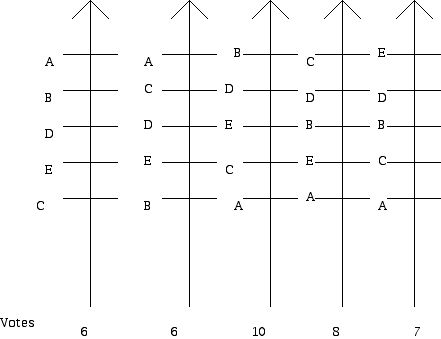Ordinal Ballot Election Practice 2 (2017)
Prepared by:
Joseph Malkevitch
Department of Mathematics
York College (CUNY)
Jamaica, New York 11451
email:
malkevitch@york.cuny.edu
web page:
http://york.cuny.edu/~malk
For the election below:

i. How many first place votes did A get? did D get? Did C get?
ii. Determine the winner (if there is one) using the methods. If a tie results break the tie in some reasonable way and explain the method used to break the tie.
a. Plurality
b. Condorcet
(As part of your solution draw a digraph which shows who beats whom in a two-way race. Use a directed edge from X to Y if X beats Y in a two-way contest.)
c. Borda count (to find the count for a candidate use the number of candidates below that person on the ordinal ballot)
(as part of your solution construct a pairwise preference matrix.)
d. Sequential run-off
e (Standard) Run-off
f. Borda count sequential run-off
g. Coombs
h. Bucklin
Bucklin works as follow: If no one wins a majority based of the first place votes, look at only first and second place votes, to see if someone now has a majority. Continue until a winner emerges. Note at some point several people may have a majority.
i. Baldwin's method (sequential run-off based on the Borda Count).
Note:
Do any of the methods pick the same winner? Will this always happen?
What method do you think is best? Are you bothered by a method that elects someone who gets no first place votes?

